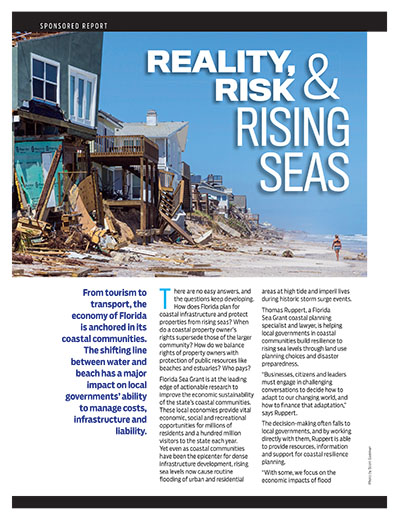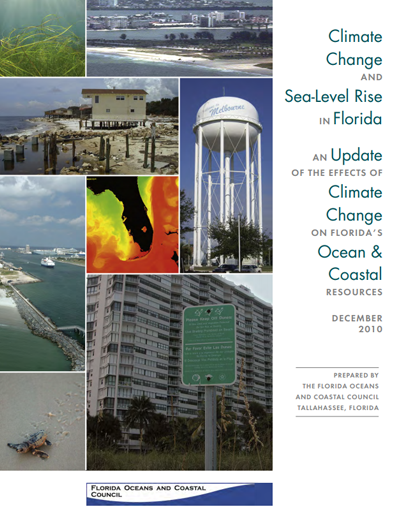To order publications, email the publication number and title to info@flseagrant.org. Be sure to include your mailing address and phone number.
Florida Trend Report: Reality, Risk and Rising Seas
From tourism to transport, the economy of Florida is anchored in its coastal communities. The shifting line between water and beach has a major impact on local government' ability to manage costs, infrastructure and liability.
November 2017
Florida Trend Report
This report in Florida Trend magazine discusses the shifting line between water and beach and how it has a major impact on local governments’ ability to manage costs, infrastructure and liability.
Questions and Answers About Flood Insurance
April 2015
Thomas Ruppert
Not sure where to start with purchasing flood insurance for your home? This new frequently asked questions guides answers any questions you might have about the National Flood Insurance Program in an easy-to-read format.
Options to Reduce High Volume Freshwater Flows to the St. Lucie and Caloosahatchee Estuaries and Move More Water from Lake Okeechobee to the Southern Everglades
March 2015
An Independent Technical Review by the University of Florida Water Institute
This report provides a review of relevant plans, projects and related technical documents as part of a broader effort to evaluate options to move more fresh water from Lake Okeechobee to the Everglades. The review was stimulated, in large part, by concern that recent regulatory releases of fresh water from Lake Okeechobee to the St Lucie and Caloosahatchee estuaries have resulted in substantial negative ecological and economic impacts. Findings and opinions expressed herein are the collective work of a team of faculty affiliated with the University of Florida Water Institute and are based solely on pre-existing information.
Climate Change and the Occurrence of Harmful Microorganisms in Florida’s Ocean and Coastal Waters
SGEF-216
July 2015
By Karl Havens
Climate change is expected to result in increased temperatures of nearshore ocean water, and this could lead to increased growth of harmful microorganisms. These include algae that form noxious or toxic blooms, including red tides, and bacteria and other pathogens. This situation could have negative consequences in regard to human health and also Florida’s ocean-related economy.
Climate Change and Ecosystem Services of Florida’s Largest Water Body: Lake Okeechobee
SGEF-217
July 2015
By Karl Havens
Future climate change could result in higher temperatures and greater evaporative water loss in Florida. If these changes are not compensated for by more rainfall, the state’s largest water body, Lake Okeechobee, could experience prolonged periods of very low water levels and catastrophic loss of its ecosystem services, which are the benefits that people receive from ecosystems.
Climate Change: Effects on Salinity in Florida’s Estuaries and Responses of Oysters, Seagrass, and Other Animal and Plant Life
SGEF-218
July 2015
By Karl Havens
Florida’s economically important estuaries could be heavily impacted by sea-level rise and altered river flow, both caused by climate change. The resulting higher salinity, or saltiness of the water, could harm plants and animals, alter fish and bird habitat, and reduce the capacity of estuaries to provide such important services as seafood production and the protection of shorelines from erosion.
The Potential Effects of Sea-Level Rise on Florida’s Coastal Ecosystems
SGEF-205
October 2013
By Whitney Gray
Sea-level rise may have significant effects on Florida’s coastal ecosystems. These ecosystems are the foundation upon which much of Florida’s natural beauty and economy are based. Understanding what changes may happen in the future can help us plan for those changes and, to the extent possible, lessen the impacts of those changes.
Climate Change and Sea-Level Rise in Florida: An Update on the Effects of Climate Change on Florida’s Ocean and Coastal Resources
December 2010
Prepared by the Florida Oceans and Coastal Council
Tallahassee, Fla.








